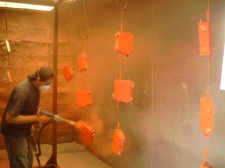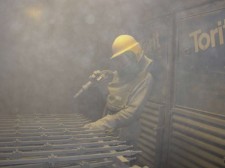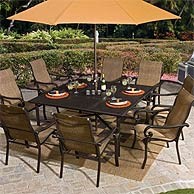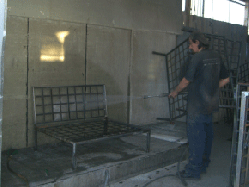 |
Step 1
The first and most important step to powder coating is the pretreatment.
Powder Coating Unlimited understands this importance and treats all necessary parts with a high temperature Iron Phosphate rinse.
Phosphating allows surface from future corrosion.
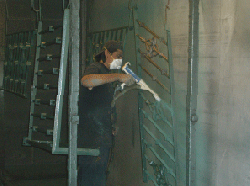 |
Step 2
After pre- cleaning the parts to a dry, bare metal surface, a special electrostatic spray gun with 30,000 to 90,000 volts is used to apply a thin layer of "plastic" powder on to a pre-heated surface of the part to be coated.
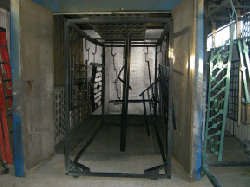 |
Step 3
The final Step is a very important step to the finish coat.
The powder is held on to the part by static electricity.
Once coated, the parts are baked at 375 to 415 Fahrenheit.
The curing oven melts the dry powder to a "gel state" and then further curing causes this gel to harden into a very tough "plastic" coating.
This flowing and fusing of the coating in the final curing oven creates a continuous coating which is very hard and had no porosity.
What is powder coating?
History of Powder Coating
Powder coating is by far the youngest of the surface finishing techniques in common use today. It was first used in Australia about 1967.
Powder coating is the technique of applying dry paint to a part. The final cured coating is the same as a 2-pack wet paint. In normal wet painting such as house paints, the solids are in suspension in a liquid carrier, which must evaporate before the solid paint coating is produced.
In powder coating, the powdered paint may be applied by either of two techniques.
- The item is lowered into a fluidised bed of the powder, which may or may not be electrostatically charged, or
- The powdered paint is electrostatically charged and sprayed onto the part.
The part is then placed in an oven and the powder particles melt and coalesce to form a continuous film.
There are two main types of powder available to the surface finisher:
- Thermoplastic powders that will remelt when heated, and
- Thermosetting powders that will not remelt upon reheating. During the curing process (in the oven) a chemical cross-linking reaction is triggered at the curing temperature and it is this chemical reaction which gives the powder coating many of its desirable properties.
Preparation
The basis of any good coating is preparation. The vast majority of powder coating failures can be traced to a lack of a suitable preparation.
The preparation treatment is different for different materials.
In general, for all applications the preparation treatment for aluminium is as follows:
| Clean | Or | Clean |
| Rinse | Rinse | |
| Etch | Etch | |
| Rinse | Rinse | |
| Chromate | Phosphate | |
| Rinse | Rinse | |
| Demin Rinse | Demin Rinse |
Oils and greases are removed in weak alkali or neutral detergent solutions and the surface is etched to remove heavy oxides. After rinsing, the aluminium is dipped into a chromate or phosphate solution to form a conversion coating on the aluminium. This film is chemically attached to the aluminium. After rinsing the aluminium is finally rinsed in demineralised water. Some non-chrome, dried in place pretreatment is beginning to come onto the market; currently, these are not recommended for exterior applications.
The conversion coating has two functions:
- It presents a surface to the powder which favours adhesion more than the oxides that form very readily on aluminium surfaces, and
- It reduces the incidence of under film corrosion, which may occur at holidays in the coating.
The use of demineralised water reduces the presence of chemical salts on the aluminium surface. These salts have been found to cause filiform corrosion in humid conditions.
For steel the preparation for interior applications may be:
| Clean |
| Rinse |
| Derust |
| Rinse |
| Iron Phosphate |
| Rinse |
| Acidulated Rinse |
For exterior applications:
| Clean |
| Rinse |
| Etch |
| Rinse |
| Grain Refine |
| Zinc Phosphate |
| Rinse |
| Acidulated Rinse |
The grain refiner is used after acid cleaning of steel surfaces and before zinc phosphating, otherwise the zinc phosphate coatings produced will be very coarse with low adhesion. The powder coating applied to a coarse phosphate will produce rough coatings (a little like "sandpaper") and possess low adhesion.
For hot dipped galvanized coatings, which have been stored for more than about 4 hours before powder coating, the following process is necessary for exterior applications.
| Clean |
| Rinse |
| Etch |
| Rinse |
| Grain Refiner |
| Rinse |
| Zinc Phosphate |
| Acidulated Rinse |
The etch is required to remove the zinc corrosion products which begin to form almost immediately the zinc is removed from the galvanizing kettle. The grain refiner ensures a fine phosphate is produced.
How is it done -- electrostatic spray?
The powder is applied with an electrostatic spray gun to a part that is at earth (or ground) potential.
Before the powder is sent to the gun it is fluidised:
- to separate the individual grains of powder and so improve the electrostatic charge that can be applied to the powder and
- so that the powder flows more easily to the gun.
Because the powder particles are electrostatically charged, the powder wraps around to the back of the part as it passes by towards the air offtake system. By collecting the powder, which passes by the job, and filtering it, the efficiency of the process can be increased to 95% material usage.
The powder will remain attached to the part as long as some of the electrostatic charge remains on the powder. To obtain the final solid, tough, abrasion resistant coating the powder coated items are placed in an oven and heated to temperatures that range from 160 to 210 degrees C (depending on the powder).
Under the influence of heat a thermosetting powder goes through 4 stages to full cure.
MELT, FLOW, GEL, CURE
The final coating is continuous and will vary from high gloss to flat matt depending on the design of the powder by the supplier.
Powder coating guns
There are at east three types of electrostatic guns in use:
- Corona charging guns where electric power is used to generate the electrostatic charge. Corona guns are either internal or external charging.
- Tribo charging guns where the electrostatic charge is generated by friction between the powder and the gun barrel.
- "Bell" charging guns where the powder is charged by being "flung" from the perimeter of the "bell"
Not all powder is applied using guns. One system makes use of electrostatic tunnels.
How is color introduced?
Colour is added to powder coatings during the manufacturing process, ie before the powder reaches the powder coater. There is little that can be done to change the colour consistently, once the powder leaves the manufacturing plant.
Installations and maintenance
During installations, the powder coating should be protected from damage due to abrasion and materials of construction such as mortar and brick cleaning chemicals.
Once installed, maintaining the initial appearance of a powder coating is a simple matter. The soot and grime which builds up on surfaces from time to time contains moisture and salts which will adversely affect the powder coating and must be removed. Powder coatings should be washed down regularly (at least once each 6 months in less severe applications and more often in marine and industrial environments). The coating should be washed down with soapy water -- use a neutral detergent -- and rinsed off with clean water.
When powder coated items are installed without damage to the powder coating and they are maintained regularly, they should be relatively permanent. The correctly applied coating, although not metallurgically bonded to the metal will not crack, chip or peel as with conventional paint films.
What types of items can be powder coated
Powder coatings are now used on hundreds of parts and products, with ongoing technological breakthroughs expanding the list every
day. The appliance industry is a major user as well as the automotive industry using powders on wheels, bumpers, hubcaps, door handles, iron gates, decorative trims and accent parts, radiators, and numerous engine parts.
Farmers have powder coated tractors and farm equipment. Fitness buffs use golf clubs and golf carts, ski poles, snowmobiles,
bicycles, motorcycles, and exercise equipment that are powder coated and many other items to much to list.
ALUMINIUMTREATMENT
Overview
Powder Coating Unlimited help customers with many different types of aluminum surfaces, ranging from small articles to large vehicle components; from both interior and exterior architectural parts to special assemblies for the aviation and aerospace industry. They manufacture a selection of cleaners, desmutters, etchants and sealants. These products result in higher quality, improved consistency, and substantial cost savings. Wherever the surface should be cleaned, deoxidized, protected from corrosion and prepared in an optimal way for a finish coating, HST offer the ideal process. Each is designed to provide superior performance in accelerated testing, such as salt fog exposure on unpainted surfaces in the aerospace industry and filiform testing for manufacturers of aluminum wheels.
Prior to coating or anodizing, the surface of an aluminum part has to be cleaned of grease and oil, pigment, polishing and grinding pastes as well as oxides. Powder Coating Unlimited offers a full range of water-borne cleaning products for these purposes and they can be used depending upon the specific requirements (material, degree of soiling, intended application).
Satisfaction Guaranteed ...
- Your finished products will ultimately end up at a higher level of quality and have and have a more esthetically pleasing appeal because the powder coating process is applied evenly and consistently.
- Your finished products will have greater durability because the powder coating process bonds in a superior manner preventing possible flaking, bubbling and minimizes the opportunity for corrosion.
- You will achieve a higher level of customer satisfaction do to product appearance and greater reliability of the surface finish.
- Your customers will be happier because they know they receive high quality products.
- You will have increased confidence in knowing that your products are the best.
- Your company’s reputation will improve because you produce a superior product.
- Your bottom line increases as a result of increased sales.
- Fewer customer problems to worry about and handle

